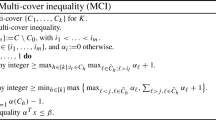Abstract
This paper describes Benders decomposition approaches to optimally solve set covering problems “ almost” satisfying the consecutive ones property. The decompositions are based on the fact that set covering problems with consecutive ones property have totally unimodular coefficient matrices. Given a binary matrix, a totally unimodular matrix is enforced by filling up every row with ones between its first and its last non-zero entries. The resulting mistake is handled by introducing additional integer variables whose number depends on the reordering of the columns of the given matrix. This leads us to consider the consecutive block minimization problem. Two cutting plane algorithms are proposed and run on a large set of benchmark instances. The results obtained show that the cutting plane algorithms outperform an existing tree search method designed exclusively for such instances.
Similar content being viewed by others
References
Beasley JE (1992) Enhancing an algorithm for set covering problems. Eur J Oper Res 58:293–300. doi:10.1016/0377-2217(92)90215-U
Benders J (1962) Partitioning procedures for solving mixed-variables programming problems. Numer Math 4:238–252. doi:10.1007/BF01386316
Binato S, Pereira MVF, Granville S (2001) A new Benders decomposition approach to solve power transmission network design problems. IEEE Trans Power Syst 16:235–240. doi:10.1109/59.918292
Booth KS, Lueker GS (1976) Testing for the consecutive ones property, interval graphs and graph planarity using PQ-tree algorithms. J Comp Syst Sci 13:335–379. doi:10.1016/S0022-0000(76)80045-1
Caprara A, Fischetti M, Toth P (2000) Algorithms for the set covering problem. Ann Oper Res 98:353–371. doi:10.1023/A:1019225027893
Cordeau JF, Soumis F, Desrosiers J (2000) A Benders decomposition approach for the locomotive and car assignment problem. Transp Sci 34:133–149. doi:10.1287/trsc.34.2.133.12308
Cordeau JF, Stojkovic G, Soumis F (2001) Benders decomposition for simultaneous aircraft routing and crew scheduling. Transp Sci 35:1415–1429. doi:10.1287/trsc.35.4.375.10432
Costa AM (2005) A survey on Benders decomposition applied to fixed-charge network design problems. Comput Oper Res 32:1429–1450. doi:10.1016/j.cor.2003.11.012
Dongarra JJ (2013) Performance of various computers using standard linear equations software. Technical Report CS-89-85, University of Manchester
Feige U (1998) A threshold of \(log\,n\) for approximating set cover. J ACM 45:634–652. doi:10.1145/285055.285059
Fisher ML, Kedia P (1990) Optimal solution of set covering/partitioning problems using dual heuristics. Manag Sci 36:674–688. doi:10.1287/mnsc.36.6.674
Garey MR, Johnson DS (1979) Computers and intractability: a guide to the theory of NP-completeness. Freeman, San Francisco
Garfinkel R, Nemhauser GL (1972) Integer programming. Wiley, New York
Geoffrion AM, Graves G (1974) Multicommodity system design by Benders decomposition. Manag Sci 20:822–844. doi:10.1287/mnsc.20.5.822
Haddadi S (2002) A note on the NP-hardness of consecutive block minimization problem. Int Trans Oper Res 9:775–777. doi:10.1111/1475-3995.00387
Haddadi S, Slimani O (2007) Alternative decomposition based approaches for assigning disjunctive tasks. Algorithm Oper Res 2:129–136
Haddadi S, Layouni Z (2008) Consecutive block minimization is 1.5-approximable. Inf Process Lett 108:132–135. doi:10.1016/j.ipl.2008.04.009
Hamacher HW, Liebers A, Schöbel A, Wagner D, Wagner F (2001) Locating new stops in a railway network. Electron Notes Theor Comput Sci 50:13–23. doi:10.1016/S1571-0661(04)00162-8
Kranakis E, Penna P, Schlude K, Taylor DS, Widmayer P (2003) Improving customer proximity to railway stations. In: Proceedings of the 5th Italian conference on algorithms and complexity (CIAC2003), pp 264–276. doi:10.1007/3-540-44849-7_30
Magnanti TL, Mireault P, Wong RT (1986) Tailoring Benders decomposition for uncapacitated network design. Math Program Study 26:112–154. doi:10.1007/BFb0121090
Mammana MF, Mecke S, Wagner D (2004) The station location problem on two intersecting lines. Electron Notes Theor Comput Sci 92:52–64. doi:10.1016/j.entcs.2003.12.022
Mecke S, Schöbel A, Wagner D (2006) Stop location-complexity and approximation issues. In: Proceedings of ATMOS
Mecke S, Wagner D (2004) Solving geometric covering problems by data reduction. Proceedings of European Symposium on Algorithms (ESA), pp 760-771. doi:10.1007/978-3-540-30140-0_67
Mercier A, Cordeau JF, Soumis F (2005) A computational study of Benders decomposition for the integrated aircraft routing and crew scheduling problem. Comput Oper Res 32:1451–1476. doi:10.1016/j.cor.2003.11.013
Naoum-Sawaya J (2007) New Benders’ decomposition approaches for W-CDMA telecommunication network design. Dissertation, University of Waterloo
Ruf N, Schöbel A (2004) Set covering with almost consecutive ones property. Discrete Optim 15:215–228. doi:10.1016/j.disopt.2004.07.002
Schöbel A, Hamacher HW, Liebers A, Wagner D (2009) The continuous stop location problem in public transportation. Asia Pac J Oper Res 26:13–30. doi:10.1142/S0217595909002080
Schrijver A (1986) Theory of linear and integer programming. Wiley, New York
Toregas T, ReVelle C (1973) Binary logic solutions to a class of location problems. Geogr Anal 5:145–155. doi:10.1111/j.1538-4632.1973.tb01004.x
Yang J, Leung JY-T (2003) A generalization of the weighted set covering problem. Nav Res Logist 52:142–149. doi:10.1002/nav.10093
Acknowledgments
We are very grateful to N. Ruf, from the university of Kaiserslautern, Germany, for providing us with the data set “ C1P-data”. Also, we would like to acknowledge the anonymous referees for their contribution in improving the quality of the manuscript.
Author information
Authors and Affiliations
Corresponding author
Rights and permissions
About this article
Cite this article
Haddadi, S. Benders decomposition for set covering problems. J Comb Optim 33, 60–80 (2017). https://doi.org/10.1007/s10878-015-9935-1
Published:
Issue Date:
DOI: https://doi.org/10.1007/s10878-015-9935-1




